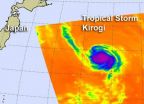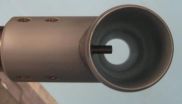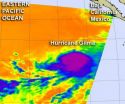(Press-News.org) Sea surface temperatures cooler than 80 degrees Fahrenheit can sap the strength from a tropical cyclone and Tropical Storm Kirogi is headed toward waters below that threshold on its track through the northwestern Pacific Ocean, according to data from NASA's Aqua satellite.
NASA's Aqua satellite passed over Tropical Storm Kirogi on August 9 at 0241 UTC. The Atmospheric Infrared Sounder (AIRS) instrument captured an infrared image of the cloud temperatures that showed a concentrated area of strongest storms and heaviest rainfall west of the center of circulation. Vertical wind shear is currently at 10-15 knots, which is helping to prevent the storm from intensifying. The center of circulation also appears elongated from northwest to southeast in satellite imagery, which is a sign the storm is weakening. Whenever a tropical storm's center cannot "stack up" in the atmosphere, it begins to weaken.
On August 9, 2012 at 11 a.m. EDT (1500 UTC), Tropical Storm Kirogi had maximum sustained winds near 35 knots (40 mph/64.8 kmh). It was located about 550 nautical miles (633 miles/1,019 km) east-southeast of Misawa, Japan, near 38.5 North and 151.9 East. Kirogi was moving to the northwest at 20 knots (23 mph/37 kmh).
AIRS data indicates that the sea surface temperatures in the direction that Kirogi is moving are too cool to maintain a tropical cyclone. Kirogi is forecast to track over sea surface temperatures cooler than 25 Celsius once it nears 38 degrees north later on August 9, which will weaken the storm. The forecasters at the Joint Typhoon Warning Center note that the cooler waters will also help transform Kirogi's warm core to a cold core, making the storm into an extra-tropical one as it heads toward the two southernmost Kuril Islands.
INFORMATION:
NASA sees Tropical Storm Kirogi headed for cooler waters
2012-08-10
ELSE PRESS RELEASES FROM THIS DATE:
Height, weight and BMI changes seen in children treated with peginterferon alpha for hepatitis C
2012-08-10
Follow-up research from the Pediatric Study of Hepatitis C (PEDS-C) trial reveals that children treated with peginterferon alpha (pegIFNα) for hepatitis C (HCV) display significant changes in height, weight, body mass index (BMI), and body composition. Results appearing in the August issue of Hepatology, a journal of the American Association for the Study of Liver Diseases, indicate that most growth-related side effects are reversible with cessation of therapy. However, in many children the height-for-age score had not returned to baseline two years after stopping ...
BUSM/VA researchers uncover gender differences in the effects of long-term alcoholism
2012-08-10
(Boston) – Researchers from Boston University School of Medicine (BUSM) and Veterans Affairs (VA) Boston Healthcare System have demonstrated that the effects on white matter brain volume from long-term alcohol abuse are different for men and women. The study, which is published online in Alcoholism: Clinical and Experimental Research, also suggests that with abstinence, women recover their white matter brain volume more quickly than men.
The study was led by Susan Mosher Ruiz, PhD, postdoctoral research scientist in the Laboratory for Neuropsychology at BUSM and research ...
Soft autonomous robot inches along like an earthworm
2012-08-10
CAMBRIDGE, MA -- Earthworms creep along the ground by alternately squeezing and stretching muscles along the length of their bodies, inching forward with each wave of contractions. Snails and sea cucumbers also use this mechanism, called peristalsis, to get around, and our own gastrointestinal tracts operate by a similar action, squeezing muscles along the esophagus to push food to the stomach.
Now researchers at MIT, Harvard University and Seoul National University have engineered a soft autonomous robot that moves via peristalsis, crawling across surfaces by contracting ...
NASA's new way to track formaldehyde
2012-08-10
NASA scientist Tom Hanisco is helping to fill a big gap in scientists' understanding of how much urban pollution -- and more precisely formaldehyde -- ultimately winds up in Earth's upper atmosphere where it can wreak havoc on Earth's protective ozone layer.
He and his team at NASA's Goddard Space Flight Center in Greenbelt, Md., have developed an automated, lightweight, laser-induced fluorescence device that measures the levels of this difficult-to-measure organic compound in the lower troposphere and then again at much higher altitudes. The primary objective is determining ...
Thinking abstractly may help to boost self-control
2012-08-10
Many of the long term goals people strive for — like losing weight — require us to use self-control and forgo immediate gratification. And yet, denying our immediate desires in order to reap future benefits is often very hard to do.
In a new article in the August issue of Current Directions in Psychological Science, a journal of the Association for Psychological Science, researchers Kentaro Fujita and Jessica Carnevale of The Ohio State University propose that the way people subjectively understand, or construe, events can influence self-control.
Research from psychological ...
'Treating the whole person with autism' sets direction for parent-clinician collaboration
2012-08-10
NEW YORK, N.Y. (August 9, 2012) – Over 400 attendees from across the U.S. and around the world participated in the first national conference for families and professionals, "Treating the Whole Person with Autism: Comprehensive Care for Children and Adolescents with ASD."
Autism Speaks, the world's leading autism science and advocacy organization, organized and hosted the conference in collaboration with educational partners at Nationwide Children's Hospital (NCH), The Ohio State University Wexner Medical Center, the American Academy of Pediatrics (AAP), and the Health ...
Gecko feet hold clues to creating bandages that stick when wet
2012-08-10
VIDEO:
Researchers Alyssa Stark and Tim Sullivan test the adhesion of a geckos feet in water. Their findings may help improve the adhesion of bandages, sutures and similar items in moist...
Click here for more information.
Akron, Ohio, August 9, 2012 — Scientists already know that the tiny hairs on geckos' toe pads enable them to cling, like Velcro, to vertical surfaces. Now, University of Akron researchers are unfolding clues to the reptiles' gripping power in wet conditions ...
The cold power of Hurricane Gilma revealed by NASA satellite
2012-08-10
High, cold cloud tops with bitter cold temperatures are indicators that there's a lot of strength in the uplift of air within a tropical cyclone. NASA's Aqua satellite passed by Hurricane Gilma and saw a concentrated area of very cold cloud tops.
NASA's Aqua satellite passed over Hurricane Gilma on August 9 at 5:53 a.m. EDT. The Atmospheric Infrared Sounder (AIRS) instrument captured an infrared image of the cloud temperatures that showed the strongest storms and heaviest rainfall were wrapped around the storm's center. Cloud top temperatures in that area were as cold ...
Brain hubs boil when hoarders face pitching their own stuff
2012-08-10
In patients with hoarding disorder, parts of a decision-making brain circuit under-activated when dealing with others' possessions, but over-activated when deciding whether to keep or discard their own things, a National Institute of Mental Health (NIMH)-funded study has found. NIMH is part of the National Institutes of Health.
Brain scans revealed the abnormal activation in areas of the anterior cingulate cortex and insula known to process error monitoring, weighing the value of things, assessing risks, unpleasant feelings, and emotional decisions.
NIMH grantee David ...
UCLA scientist discovers plate tectonics on Mars
2012-08-10
For years, many scientists had thought that plate tectonics existed nowhere in our solar system but on Earth. Now, a UCLA scientist has discovered that the geological phenomenon, which involves the movement of huge crustal plates beneath a planet's surface, also exists on Mars.
"Mars is at a primitive stage of plate tectonics. It gives us a glimpse of how the early Earth may have looked and may help us understand how plate tectonics began on Earth," said An Yin, a UCLA professor of Earth and space sciences and the sole author of the new research.
Yin made the discovery ...




